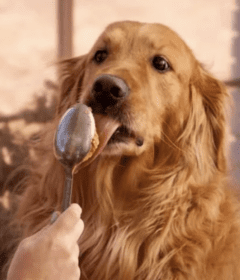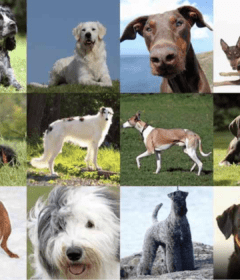Types of Retriever Breeds
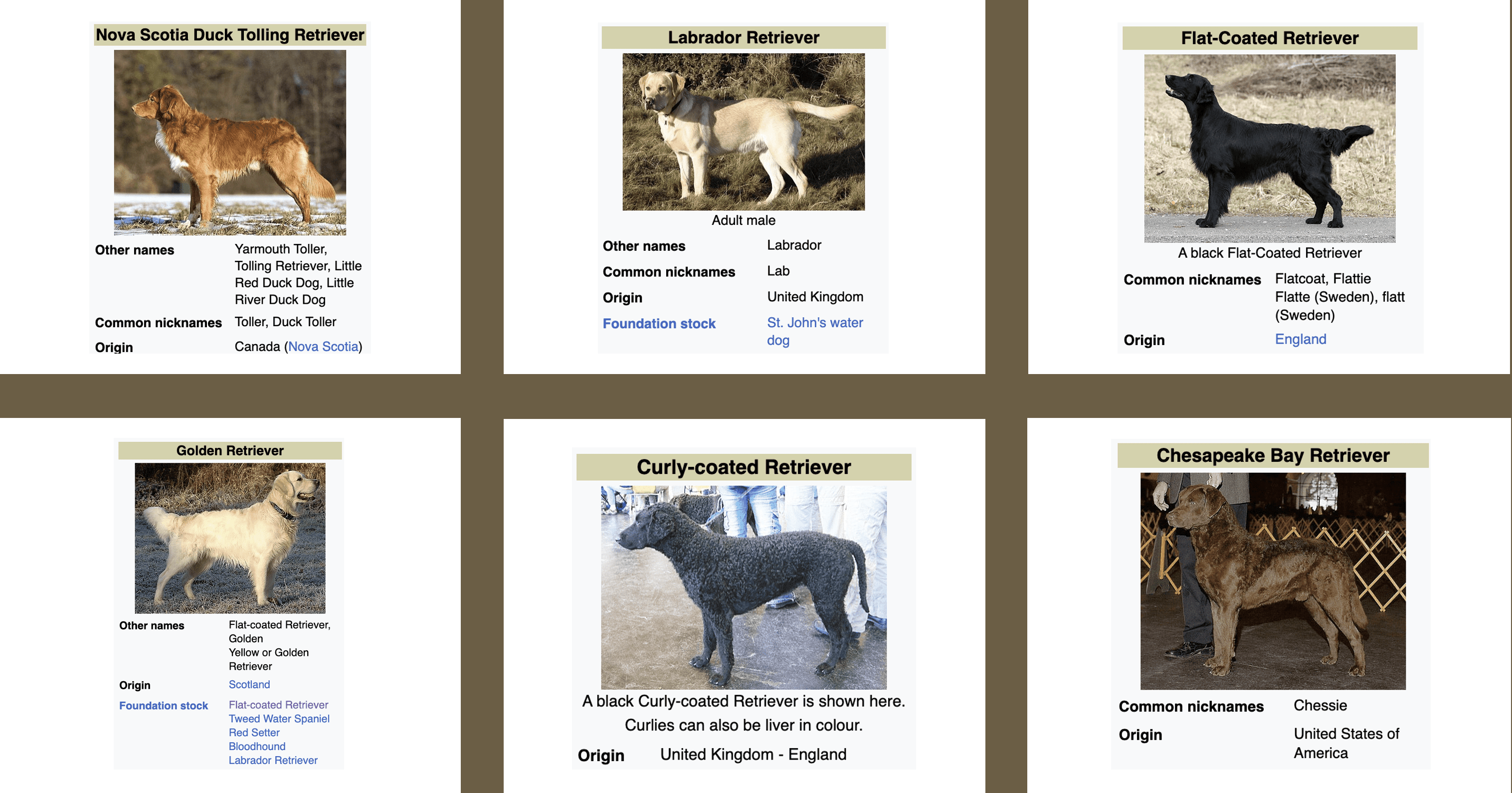
Types of Retriever Breeds – A retriever is a type of gun dog that retrieves game for a hunter.
Generally gun dogs are divided into three major classifications: retrievers, flushing spaniels, and pointing breeds.
A retriever is a type of gun dog that retrieves game for a hunter.
Types of Retriever Breeds – Retrievers were bred primarily to retrieve birds or other prey and return them to the hunter without damage; retrievers are distinguished in that nonslip retrieval is their primary function.
Types of Retriever Breeds – As a result, retriever breeds are bred for soft mouths and a great willingness to please, learn, and obey.
A soft mouth refers to the willingness of the dog to carry game in its mouth without biting into it.
“Hard mouth” is a serious fault in a hunting dog and is very difficult to correct.
Types of Retriever Breeds – A hard-mouthed dog renders game unpresentable or at worst inedible.
Retriever Breeds
Chesapeake Bay Retriever
Curly Coated Retriever
Flat Coated Retriever
Golden Retriever
Labrador Retriever
Nova Scotia Duck Tolling Retriever
Murray River Retriever
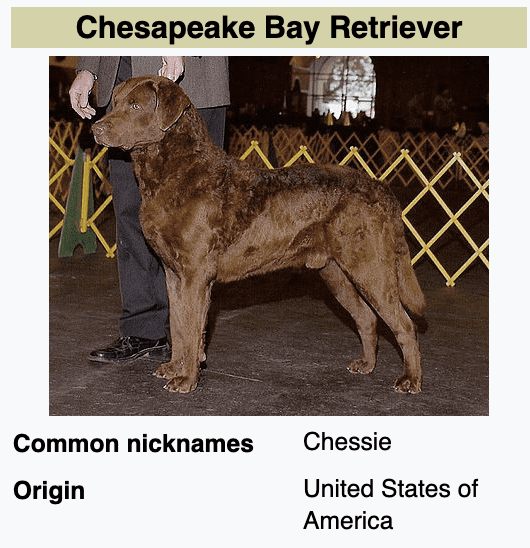
Types of Retriever Breeds Chesapeake Bay Retrievers
The Chesapeake Bay Retriever descended from two dogs who were saved from an English brig wrecked off the coast of Maryland in 1807.
Along with the crew and cargo were rescued two St. John’s Newfoundland puppies—a dingy red dog named Sailor, and a black bitch named Canton.
These dogs were given to people in the local community, and they turned out to be excellent natural retrievers.
The Chesapeake Bay Retriever is a large breed of dog belonging to the retriever, gundog, and sporting breed groups.
The breed was developed in the United States Chesapeake Bay area during the 19th century.
Historically used by local market hunters to retrieve waterfowl, pull fishing nets, and rescue fishermer.
Retrievers today are primarily a family pet and hunting companion, known for a bright and happy disposition; courage; willingness to work; alertness; intelligence; love of water; and hunting capabilities.
The Chesapeake is a medium- to large-sized dog similar in appearance to the Labrador Retriever, but with a wavy coat.
Distinctive features include eyes that are very clear, of yellowish or amber hue, hindquarters as high or a trifle higher than the shoulders, and a double-coat that tends to wave on shoulders, neck, back, and loins.
The waterproof coat feels slightly oily and is often associated with a slight musky odor.
Three basic colors are generally seen in the breed: brown, which includes all shades from a light to a deep dark brown; sedge, which varies from a reddish yellow through a bright red to chestnut shades; and deadgrass in all its shades, varying from a faded tan to a dull straw color.
The breed standard states that white may also appear but it must be limited to the breast, belly, toes, or back of the feet.
The head is round and broad with a medium stop and muzzle.
The lips are thin, and the ears are small and of medium leather.
The forelegs should be straight with good bone.
The hindquarters are especially strong and the toes webbed since excellent swimming ability is important for the Chesapeake.
This breed is also known for its la
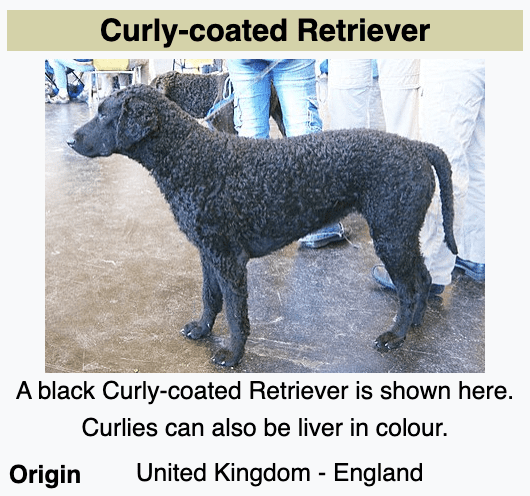
Types of Retriever Breeds Curly-Coated Retriever
The Curly-Coated Retriever is considered to be one of the oldest of all the retriever breeds.
They are thought to be descended from the 16th-century English Water Spaniel, the St. John’s Newfoundland, the retrieving setter, and, in the late 19th century, the Poodle.
Distinguished by their coat of small, tight, water-resistant curls, this multipurpose hunting retriever is reliable, robust, and highly intelligent.
One of the more independent retriever breeds, the Curly may appear somewhat aloof, but they are always willing to please.
The Curly-coated Retriever (not always hyphenated, and often called the Curly for short) is a breed of dog originally bred in England for upland bird and waterfowl hunting.
It is the tallest of the retrievers and is easily distinguishable by the mass of tight curls covering its body. Curly Coated and Wavy Coated (now known as the Flat-Coated Retriever) were the first two recognised retriever breeds, established as early as 1860.
The Curly is an active, well-muscled dog bred for upland bird and waterfowl hunting.
The Curly is somewhat different in structure than the more common retrievers.
A Curly will appear slightly leggy but is actually slightly longer than tall. It is balanced and agile with a significant air of endurance, strength, and grace.
Curlies are soft-mouthed and regularly handle game with care. Show standards call for dogs to be between 25 and 27 inches (64 and 69 cm) at the withers, and for females to be between 23 and 25 inches (58 and 64 cm).
However a wide range of sizes occurs, particularly in those dogs bred for the field, which generally run smaller.
The country of origin (United Kingdom) breed standard calls for a taller dog and bitch, with only 27 inches (69 cm) for males and 25 inches (64 cm) for females listed. Weight should be in proportion to the height of the dog.
The breed sports a coat of tight, crisp curls.
The tight curled coat of the Curly repels water, burrs, and prevents damage that other sporting dogs with softer, thinner coats cannot escape.
The only acceptable colours for the Curly-coated Retriever are solid black and solid liver.
Occasional white hairs are permissible, but large white patches are a serious fault.
Eyes should be either black or brown in black dogs, and brown or amber in liver dogs.
Yellow eyes are unusual. The nose should be fully pigmented, and the same colour as the coat as the dog.
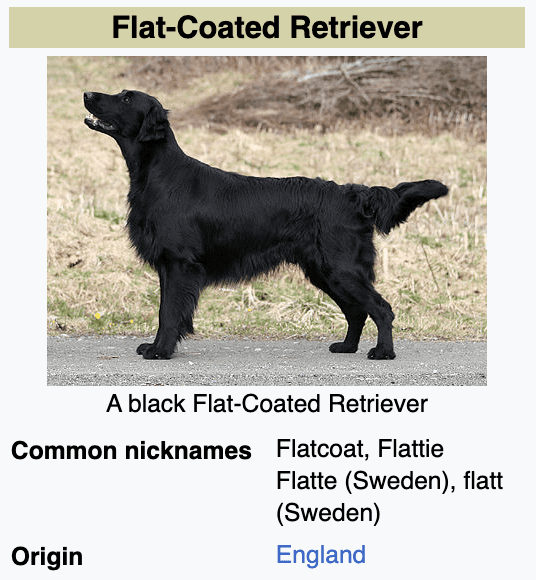
Types of Retriever Breeds Flat Coated Retriever
The Flat-Coated Retriever’s ancestors include a crossbreed emerging from the Newfoundland that was then bred to setters, sheepdogs, and spaniel-like water dogs.
Closely related to the Labrador Retriever but leaner and more elegant, the breed has a lustrous, flat-lying coat.
This coat comes in solid black or liver, with feathering at the legs and tail.
The distinctive coat protects these superb retrievers from harsh weather, icy water, and punishing ground cover.
Another breed hallmark is the long head—unique among retrievers—that projects a smart and kindly expression.
The Flat-coated Retriever is a gun dog breed originating from England. It was developed as a retriever both on land and in the water.
The Flat-Coated Retriever breed standard calls for males to be 23–25 in (58–64 cm) tall at the withers, with a recommended weight of 60–80 lb (27–36 kg).
For females to be 22–24 in (56–61 cm), with a recommended weight of 55–75 lb (25–34 kg).
The Flat-Coated Retriever has strong muscular jaws and a relatively long muzzle. Its head is unique to the breed and is described as being “of one piece” with a minimal stop and a backskull of about the same length as the muzzle.
It has almond-shaped, dark brown eyes with an intelligent, friendly expression.
The ears are pendant, relatively small, and lie close to the head. The occiput (the bone at the back of the skull) is not to be accentuated (as it is in setters, for example) with the head flowing smoothly into a well-arched neck.
The topline is strong and straight with a well-feathered tail of moderate length held straight off the back.
This breed should be well angulated front and rear, allowing for open, effortless movement.
Flat-Coated Retriever holding a gun dog dummy.
The Flat-Coated Retriever comes in three colors – black, liver, and yellow.
Although yellow is a disqualifier in conformation, they can compete in other venues.
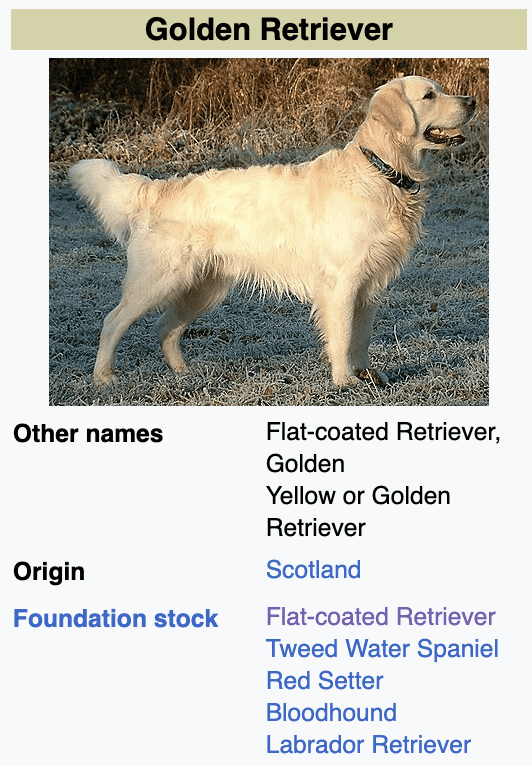
Types of Retriever Breeds The Golden Retriever
The Golden Retriever originated in the Scottish Highlands in the late 1800s.
The breed’s founder, a member of the gentry named Dudley Marjoribanks, later known as Lord Tweedmouth, wanted a superb retriever who would be well-suited to the Scottish climate.
He started with the lone yellow puppy he obtained from a litter of black Wavy-Coated Retrievers whelped in southern England in 1864.
Eventually, he bred that dog to a female Tweed Water Spaniel (a breed now extinct).
Several yellow pups that resulted became the foundation for a distinctive line of very talented yellow retrievers that became known as excellent working dogs.
Since then, the breed’s beauty, high intelligence, physical abilities, and loving personality have earned the Golden devotees.
The Golden Retriever is a Scottish breed of retriever dog of medium size. It is characterised by a gentle and affectionate nature and a striking golden coat.
It is commonly kept as a pet and is among the most frequently registered breeds in several Western countries.
It is a frequent competitor in dog shows and obedience trials; it is also used as a gun dog (a type of hunting dog for soft-mouthed retrieving of fowl) and may be trained for use as a guide dog.
The breed was created by Sir Dudley Marjoribanks at his Scottish estate Guisachan in the late nineteenth century.
He cross-bred Flat-coated Retrievers with Tweed Water Spaniels, with some further infusions of Red Setter, Labrador Retriever and Bloodhound.
The breed was recognised by the Kennel Club in 1913, and during the interwar period spread to many parts of the world.
The Golden Retriever is a powerfully built, medium-sized breed of dog; according to the Kennel Club breed standard, dogs stand from 56 to 61 centimetres (22 to 24 in) and bitches from 51 to 56 centimetres (20 to 22 in).
Healthy adult examples typically weigh between 25 and 34 kilograms (55 and 75 lb).[10]
The Golden Retriever has a broad head with a well-defined stop, with dark eyes set well apart, a wide and powerful muzzle, a large black nose, dark-pigmented and slightly drooping flews, and ears of moderate size set high and hanging with a slight fold.
The neck is muscular and fairly long with loose-fitting skin, the shoulders well laid-back and long-bladed, and the body deep through the chest with well-sprung ribs.
The back is usually level from withers to croup and the long, straight tail is usually carried flat, roughly in line with the back.
The forelegs are straight with good bone, the hind legs are powerful with well bent stifles and muscular thighs, and the feet are cat-like.
The double coat is a recognisable and striking feature:[8] the outer coat is long, flat or wavy and has good feathering on the forelegs, while the undercoat is dense and provides weather resistance.
The coat can be any shade of cream, yellow or gold; the coat typically becomes paler with age.
The Kennel Club breed standard prohibits red or mahogany-coloured coats, but a few white hairs on the chest are permitted.
Originally only yellow or golden coloured examples were permitted, this excluded many outstanding cream coloured dogs; to overcome this in 1936 the Kennel Club’s standard was amended to include the cream colour.
The cream color, which in more modern times can be almost white, has become the dominant color and is particularly favored by conformation show exhibitors.
Golden Retrievers that are bred for conformation shows tend to have longer and finer coats than those bred for working as gundogs.
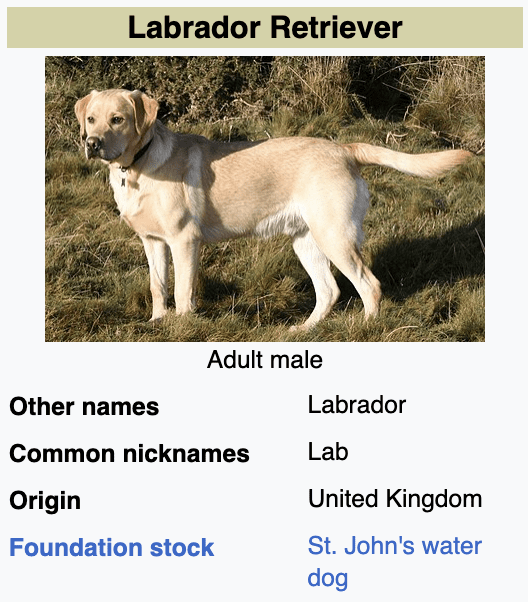
Types of Retriever Breeds Labrador Retriever
The Labrador Retriever probably originated not in the area of Labrador, in northeastern Canada, but on the adjacent island of Newfoundland.
Going back to the 1600s, fishermen in Newfoundland worked with sturdy, eager-to-please, water-loving dogs who helped haul in lines and nets and retrieved fish that fell off of hooks.
As more people settled in the St. John’s area of Newfoundland, the dogs’ excellent retrieving abilities made them very useful and popular hunting companions.
Some of these “St. John’s dogs” were brought back over to England. By the 1800s, they became prized sporting dogs for the aristocracy.
Today, the Lab is one of the most popular breeds in the U.S. and many other countries, as well.
Their intelligence, solid build, versatility, gentle and pleasant nature, and desire to please make them excel at many roles in addition to a hunting dog, including as a guide dog, for search-and-rescue work, therapy work, narcotics detection—and, of course, as a top-notch all-around companion.
The Labrador is friendly, energetic, and playful.
It was bred as a sporting and hunting dog but is widely kept as a companion dog.
It may also be trained as a guide or assistance dog, or for rescue or therapy work.
The Labrador Retriever or simply Labrador is a British breed of retriever gun dog.
It was developed in the United Kingdom from St. John’s water dogs imported from the colony of Newfoundland (now a province of Canada), and was named after the Labrador region of that colony.
It is among the most commonly kept dogs in several countries, particularly in the European world.
In the 1830s, the 10th Earl of Home and his nephews, the 5th Duke of Buccleuch and Lord John Scott, imported progenitors of the breed from Newfoundland to Europe for use as gun dogs.
Another early advocate of these Newfoundland fishing dogs was the 2nd Earl of Malmesbury, who bred them for their expertise in waterfowling.
During the 1880s, the 3rd Earl of Malmesbury, the 6th Duke of Buccleuch, and the 12th Earl of Home collaborated to develop and establish the Labrador Retriever breed.
The dogs Buccleuch Avon and Buccleuch Ned, given by Malmesbury to Buccleuch, were mated with bitches carrying blood from those originally imported by the 5th Duke and the 10th Earl of Home.
The offspring are the ancestors of all modern Labradors.
There is a great deal of variety among Labradors.
The following characteristics are typical of the conformation show bred (bench-bred) lines of this breed in the United States and are based on the American Kennel Club standard.
Significant differences between UK and U.S. standards are noted.
Size: Labradors are a medium-large breed. They should be as long from the withers to the base of the tail as they are from the floor to the withers. T
he AKC standard includes an ideal weight for dogs of 25–36 kg (55–80 lb) and for bitches as 25–32 kg (55–70 lb).
The guidelines for height vary between the AKC, which gives 55 to 62 centimeters (21.5 to 24.5 in) for dogs and 55 to 60 centimeters (21.5 to 23.5 in) for bitches.
The Kennel Club which advises that dogs should be 56 to 57 centimeters (22 to 22.5 in) with bitches between 55 and 56 centimeters (21.5 and 22 in),[13] and the FCI which quotes a range of 56 to 57 centimeters (22 to 22.5 in) for dogs with bitches ideal at 54 to 56 centimeters (21.5 to 22 in).
Coat: The Labrador Retriever’s coat should be short and dense, but not wiry.
The coat is water-resistant, so the dog does not get cold when taking to the water in the winter.
That means that the dog naturally has a slightly dry, oily coat. Acceptable colors are black, yellow, and chocolate.
Head: The head should be broad with slightly pronounced eyebrows.
The eyes should be kind and expressive.
Appropriate eye colors are brown and hazel. The lining around the eyes should be black.
The ears should hang close to the head and be set slightly above the eyes.
Jaws: The jaws should be strong and powerful.
The muzzle should be of medium length and should not be too tapered.
The jaws should hang slightly and curve gracefully back.
Body: The body should have a powerful and muscular build.
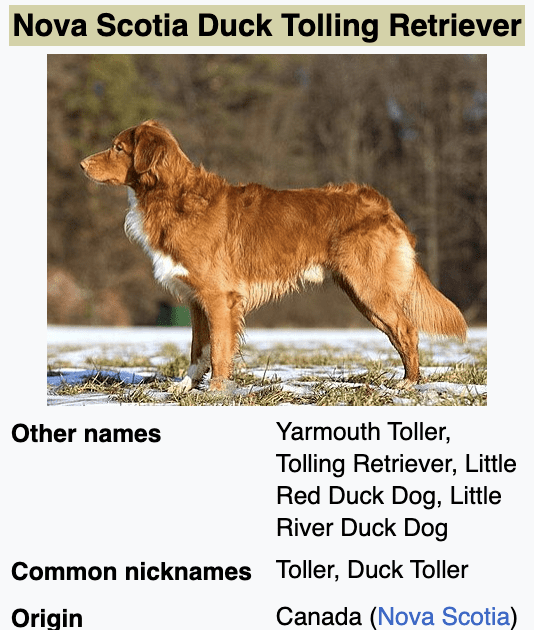
Types of Retriever Breeds Nova Scotia Duck Tolling Retriever
The Nova Scotia Duck Tolling Retriever was developed in the Little River Harbour area of Nova Scotia around the beginning of the 19th century.
This compact, agile, alert, and intelligent breed was developed for an unusual method of hunting waterfowl, known as “tolling,” where the dog’s playful action of retrieving a stick or ball draws the curiosity of birds that are out on the water, luring them into the shoreline.
This behavior was first noted in the wild, where foxes were seen to play along the shore so as to attract their waterfowl prey. Inspired by the success of the foxes, hunters trained their dogs to mimic this ploy by throwing sticks and rocks for the dogs to retrieve.
The Toller’s attractive, water-repellent double coat is any shade of red, often with white markings.
The Nova Scotia Duck Tolling Retriever is a medium-sized gundog bred primarily for hunting. It is often referred to as a “toller”.
It is the smallest of the retrievers, and is often mistaken for a small Golden Retriever. Tollers are intelligent, eager to please, alert, and energetic.
The name “toller” is derived from their ability to lure waterfowl within gunshot range. The breed originated in Yarmouth County, Nova Scotia, Canada.
The American Kennel Club ranks the toller as the 87th most popular dog breed.
Tollers are often mistaken for small Golden Retrievers, but the Toller is more active, both physically and mentally.
According to the breed standards, the Toller is athletic, muscular, compact, medium to heavy boned, balanced and powerful.
The chest is deep. Conformation judges require Tollers to be capable of tolling and physical faults that inhibit working ability are heavily penalized.
They should be of moderate build — a lack of substance or a heavy build are penalized by judges because both detract from the breed standard and athleticism.
The legs are sturdy and solid and they have webbed feet.
Tollers can be any shade of red ranging from a golden red through dark coppery red with lighter featherings on the underside of the tail, pantaloons, and body.
The lighter shades of golden red are deeply pigmented and rich in color.
The Toller should not be buff, brown, or beige, though some buff and sable Tollers do appear in breeding lines.
It is common for a Toller to have at least one of the following white markings: tip of tail, feet (not extending above the pasterns) and chest.
Lack of white is not a fault; Tollers can be born without white markings.
Dogs with white on the shoulders, around ears, back of neck, across back or flanks, or with silvery, grey or black areas in coat are disqualified from conformation shows.
The Toller was bred to retrieve from icy waters and must have a water-repellent double coat of medium length and softness and a soft dense undercoat.
The coat may have a slight wave on the back but is otherwise straight.
Some winter coats may form a long loose curl at the throat.
Featherings are soft and moderate in length, the tail is well feathered and held jauntily when the dog is excited or moving.
The hair on the muzzle is short and fine.
Seasonal shedding is to be expected.
Those who breed Tollers for conformation shows consider the head (clean cut, slightly wedge-shaped) to be an important feature and believe it should resemble that of a fox and must never be blocky like that of a Golden Retriever.
The ears are triangular and set high and well back from the skull.
The pigment on a toller’s nose, lips and eye rims should match, and should be either black (which normally fades with age) or liver, blending into the coat.
Lips fit fairly tightly around the mouth. The correct bite is a scissor bite, full dentition is required.
Jaws are strong enough to carry a large bird, but Tollers must have a soft mouth too.
Eyes are set well apart, almond shaped, and medium-sized and amber to dark brown in color.
Expression is friendly, alert, and intelligent.
Different Dog Personalities >>
All About Bernese Mountain Dogs >>

